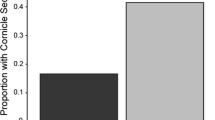Abstract
When attacked by a predator, an aphid may secrete a droplet of fluid from its cornicles containing a volatile alarm pheromone component, (E)-β-farnesene. This study investigated both qualitative and quantitative aspects of alarm pheromone production in the pea aphid, Acyrthosiphon pisum. The best predictor of cornicle droplet emission was reproductive phase, rather than instar, as prereproductive aphids were more likely to secrete cornicle droplets than either reproductive or postreproductive individuals. Analogously, alarm pheromone amounts were highest in prereproductive aphids. (E)-β-Farnesene quantities (mean ± SE) increased significantly from first instar (1.5 ± 0.6 ng) to second instar (11.2 ± 3.7 ng) and did not significantly change during third (12.8 ± 3.0 ng) or fourth instars (11.0 ± 3.7 ng). Alarm pheromone amounts then decreased significantly in adults (4.8 ± 2.3 ng). We suggest that prereproductive aphids have been selected to produce higher levels of pheromone because of their more clustered colony structure and higher levels of predation, as compared with adult aphids.
Similar content being viewed by others
REFERENCES
Abacus Concepts. 1988. Statview SE + Graphics. Abacus Concepts, Inc., Berkeley, California.
Amwack, C. S., Woodcock, C. M., and Harrington, R. 1997. Climate change may increase vulnerability of aphids to natural enemies. Ecol. Entomol. 22:366–368.
Bailey, S. M., Irwin, M. E., Kampmeier, G. E., Eastman, C. E., and Hewings, A. D. 1995. Physical and biological perturbations: Their effect on the movement of apterous Rhopalosiphum padi (Homoptera: Aphididae) and localized spread of barely yellow dwarf virus. Environ. Entomol. 24:24–33.
Busgen, M. 1891. Biologische Studien an Pflanzen und Pflanzenlausen. Wissenschaftliche Zeitschrift. Naturwiss. Reihe /Friedriche-Schiller-Univ. Jena 25:339–428.
Callow, R. K., Greenway, A. R., and Griffiths, D. C. 1973. Chemistry of the secretion from the cornicles of various species of aphids. J. Insect Physiol. 19:737–748.
Dahl, M. L. 1971. Uber einen Schreckstoff bei Aphiden. Dtsch. Entomol. Z. 18:121–128.
Dixon, A. F. G. 1958. Escape responses shown by certain aphids to the presence of Adalia decempunctata. Trans. R. Entomol. Soc. London 110:319–334.
Dixon, A. F. G. 1998. Aphid Ecology, 2nd ed. Chapman and Hall, London.
Dixon, A. F. G. and Stewart, W. A. 1975. Function of the siphunculi in aphids with particular reference to the sycamore aphid, Drepanosiphum platanoides. J. Zool. London 175:279–289.
Edwards, J. S. 1966. Defense by smear: Supercooling in the cornicle wax of aphids. Nature 211:73–74.
Frazer, B. D., and Gilbert, N. 1976. Coccinellids and aphids: A quantitative study of the impact of adult ladybirds (Coleoptera: Coccinellidae) preying on field populations of pea aphids (Homoptera: Aphididae). J. Entomol. Soc. B.C. 73:33–56.
Gut, J. P., and Van oosten, A. M. 1985. Functional significance of the alarm pheromone composition in various morphs of the green peach aphid, Myzus persicae. Entomol. Exp. Appl. 37:199–204.
Gut, J. P., Harrewijn, P., Van oosten, A. M., and Van rheenen, B. 1987. Additional function of alarm pheromones in development processes of aphids. Meded. Fac. Landbouwwet. 52:371–378.
Hodgson, C. 1991. Dispersal of apterous aphids (Homoptera: Aphididae) from their host plant and its significance. Bull. Entomol. Res. 81:417–427.
Kislow, C. J. and Edwards, L. J. 1972. Repellent odours in aphids. Nature 235:108–109.
Losey, J. E., and Denno, R. F. 1998. The escape response of pea aphids to foliar-foraging predators: Factors affecting dropping behaviour. Ecol. Entomol. 23:53–61.
Muller, F. P. 1983. Differential alarm pheromone responses between strains of the aphid Acyrthosiphon pisum. Entomol. Exp. Appl. 34:347–348.
Nault, L. R. and Montgomery, M. E. 1977. Aphid pheromones, pp. 527–545, in K. Harris and K. Maramorosch (eds.). Aphids as Virus Vectors. Academic Press, New York.
Nault, L. R. and Montgomery, M. E. 1979. Aphid alarm pheromones. Misc. Publ. Entomol. Soc. Am. 11:23–31.
Nault, L. R., and Phelan, P. L. 1984. Alarm pheromones and sociality in pre-social insects, pp. 237–256, in W. J. Bell and R. T. Cardé (eds.). Chemical Ecology of Insects. Sinauer Associates, Sunderland, Massachusetts.
Nault, L. R., Edwards, L. J., and Styer, W. E. 1973. Aphid alarm pheromones: Secretion and reception. Environ. Entomol. 2:101–105.
Pickett, J. A., and Griffiths, D. C. 1980. Composition of aphid alarm pheromones. J. Chem. Ecol. 6:349–360.
SAS Institute. 1996. JMP Start Statistics. Duxbury Press, Belmont, California.
StarÝ, P. 1970. Biology of Aphid Parasites (Hymenoptera: Aphidiidae) with Respect to Integrated Control. Dr. W. Junk, The Hague.
Stearns, S. C. 1992. The Evolution of Life Histories. Oxford University Press, Oxford.
Van Oosten, A. M., Gut, J., Harrewijn, P., and Piron, P. G. M. 1990. Role of farnesene isomers and other terpenoids in the development of different forms of the aphids Aphis fabae and Myzus persicae. Acta Phytopathol. Entomol. Hung. 25:331–342.
Zar, J. H. 1984. Biostatistical Analysis. Prentice-Hall, Englewood Cliffs, New Jersey.
Author information
Authors and Affiliations
Rights and permissions
About this article
Cite this article
Mondor, E.B., Baird, D.S., Slessor, K.N. et al. Ontogeny of Alarm Pheromone Secretion in Pea Aphid, Acyrthosiphon pisum. J Chem Ecol 26, 2875–2882 (2000). https://doi.org/10.1023/A:1026402229440
Issue Date:
DOI: https://doi.org/10.1023/A:1026402229440




